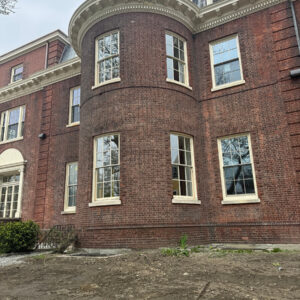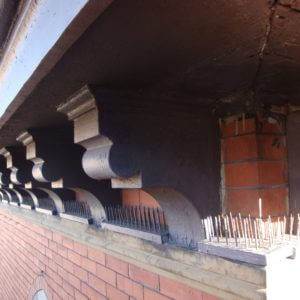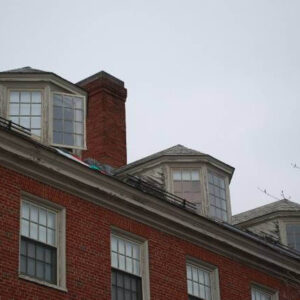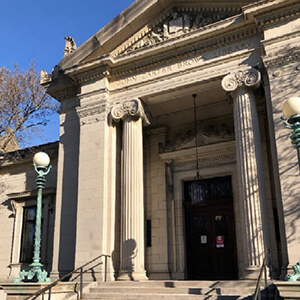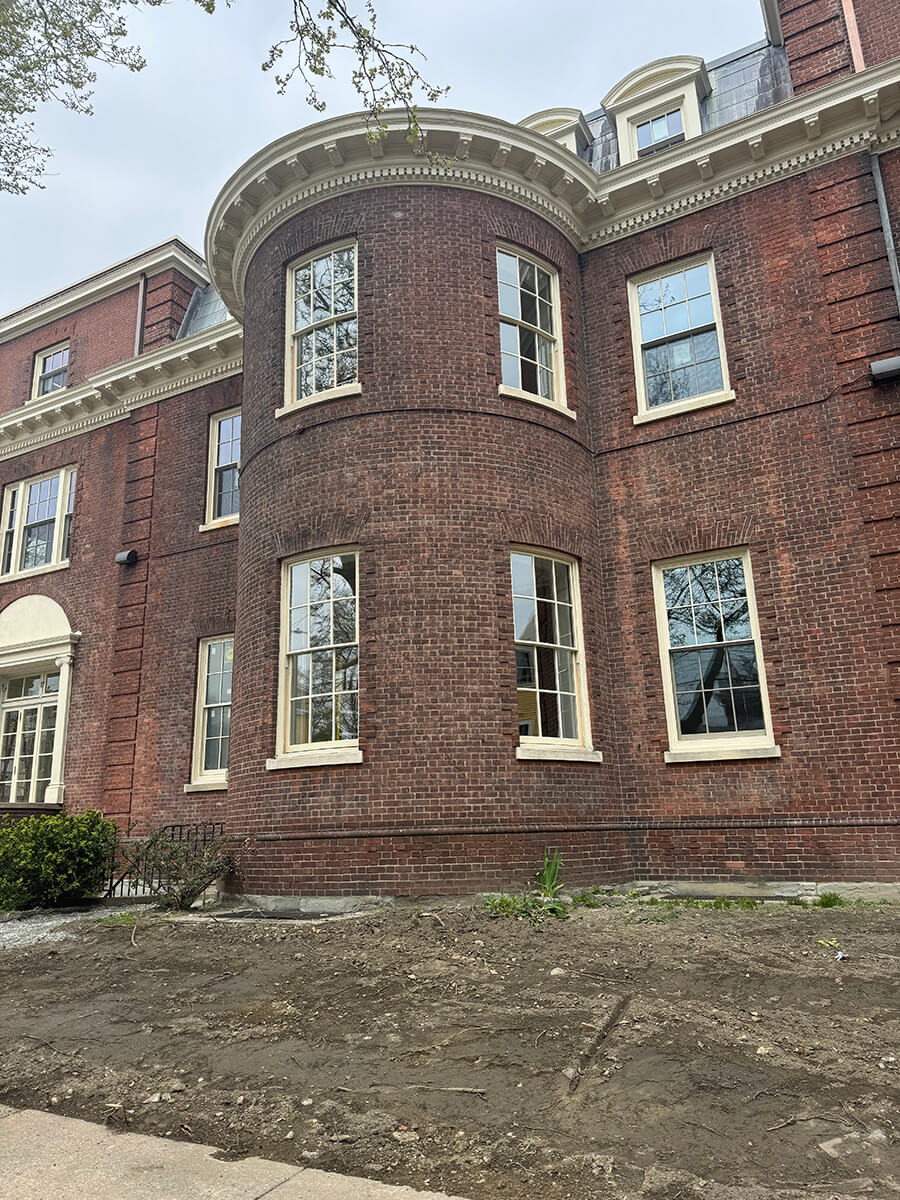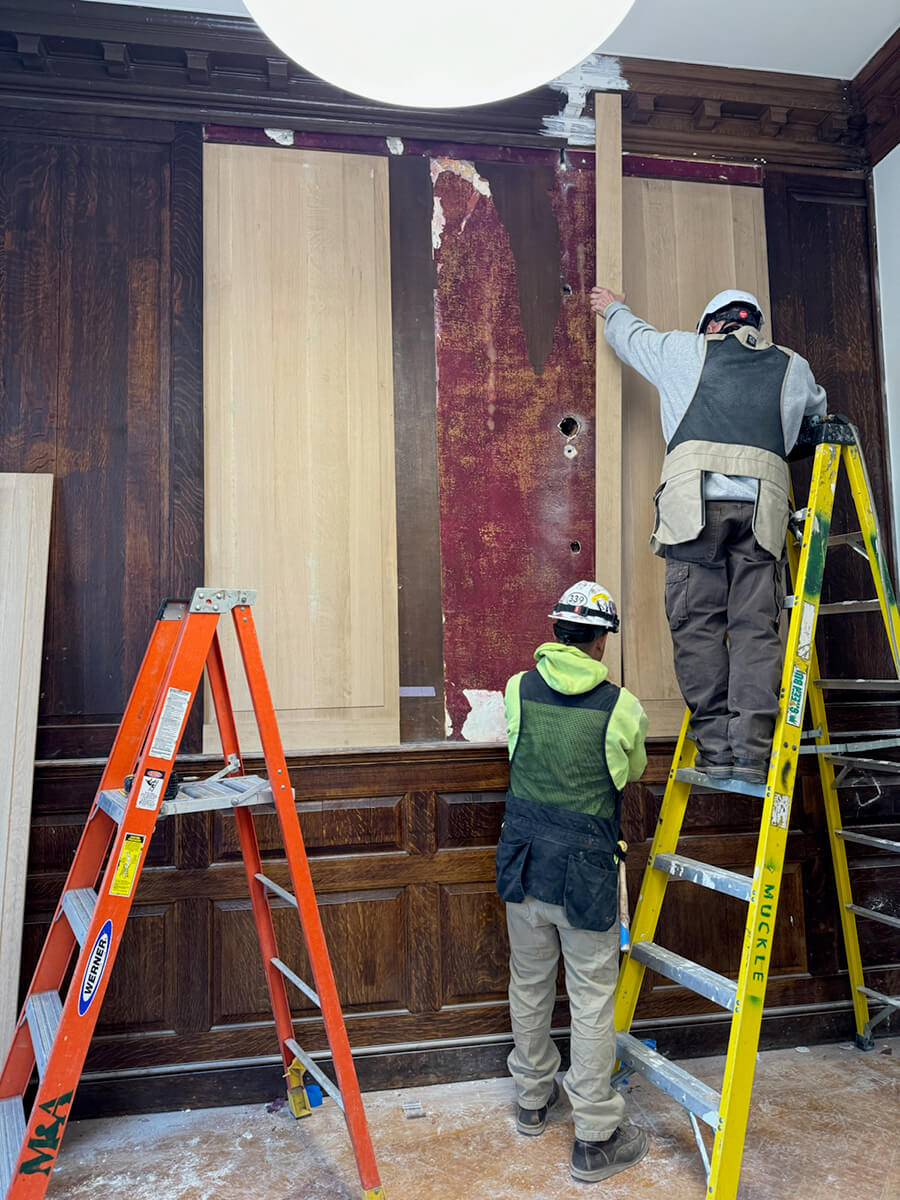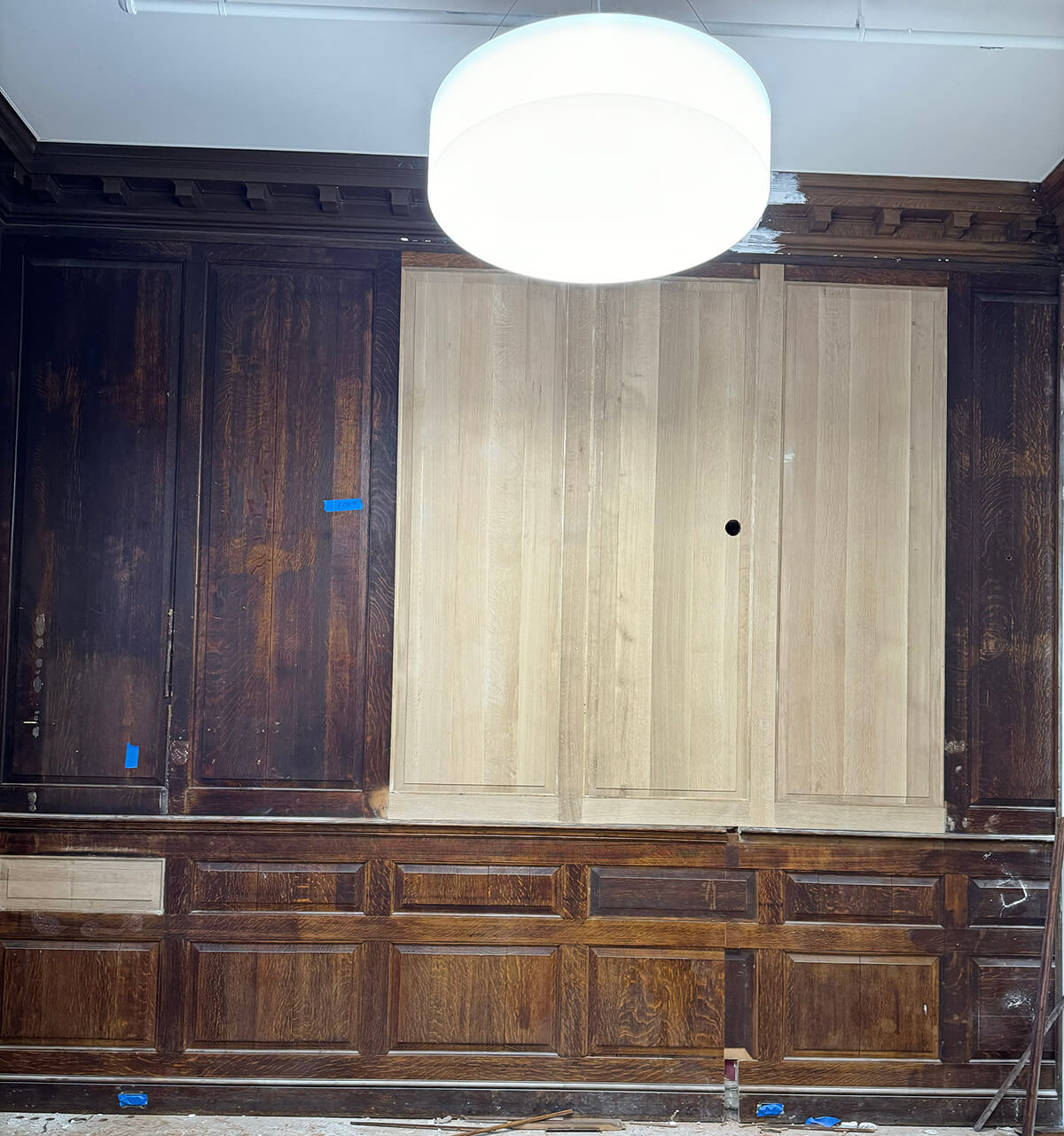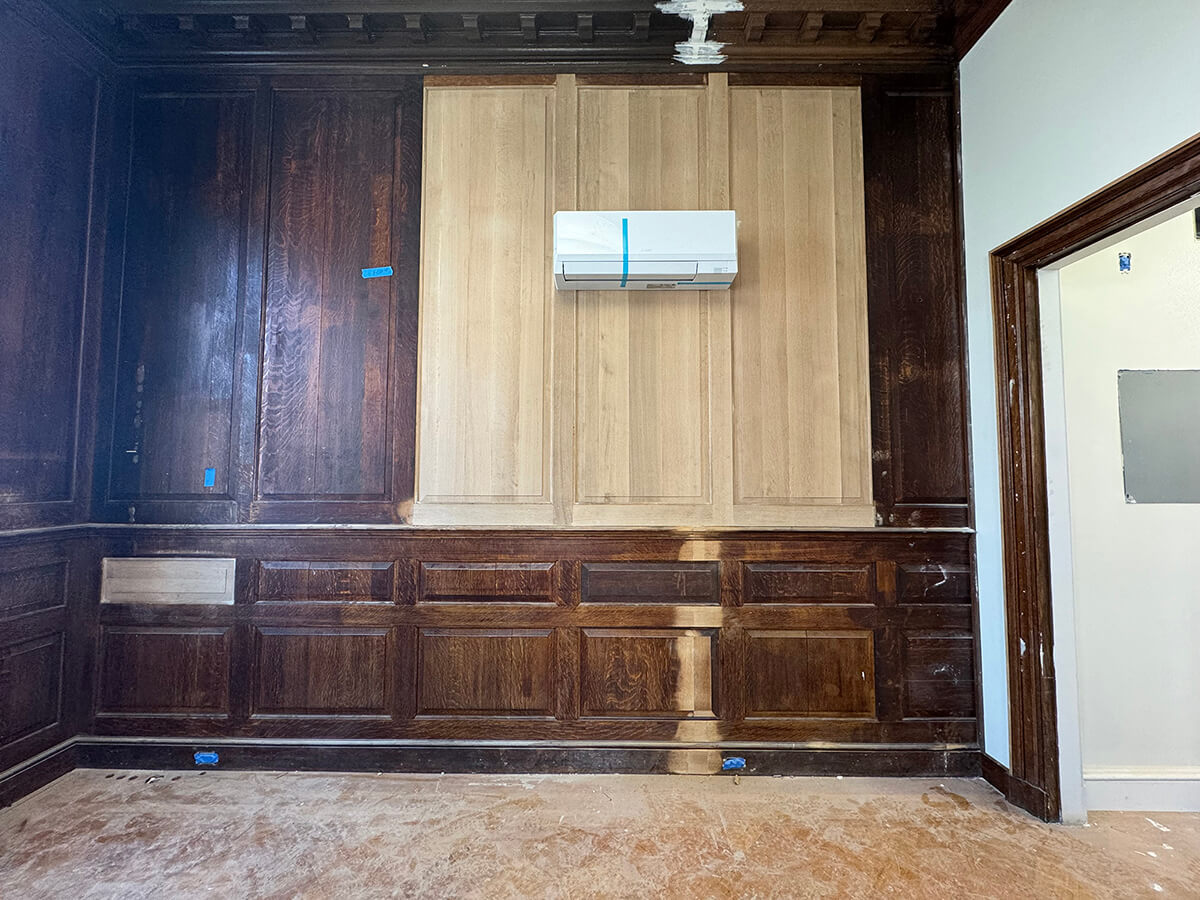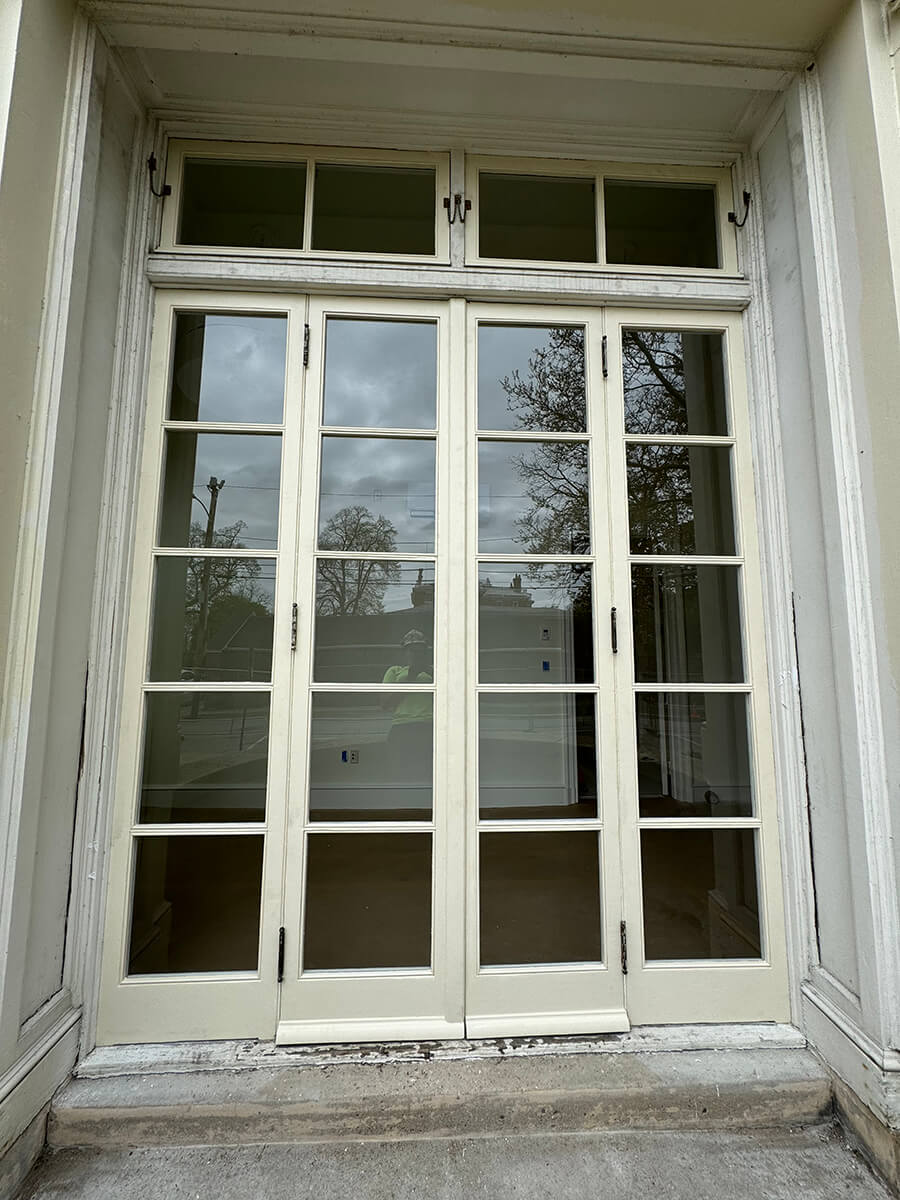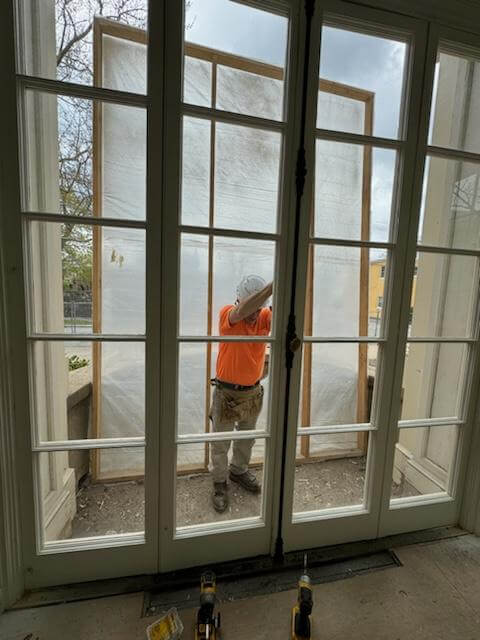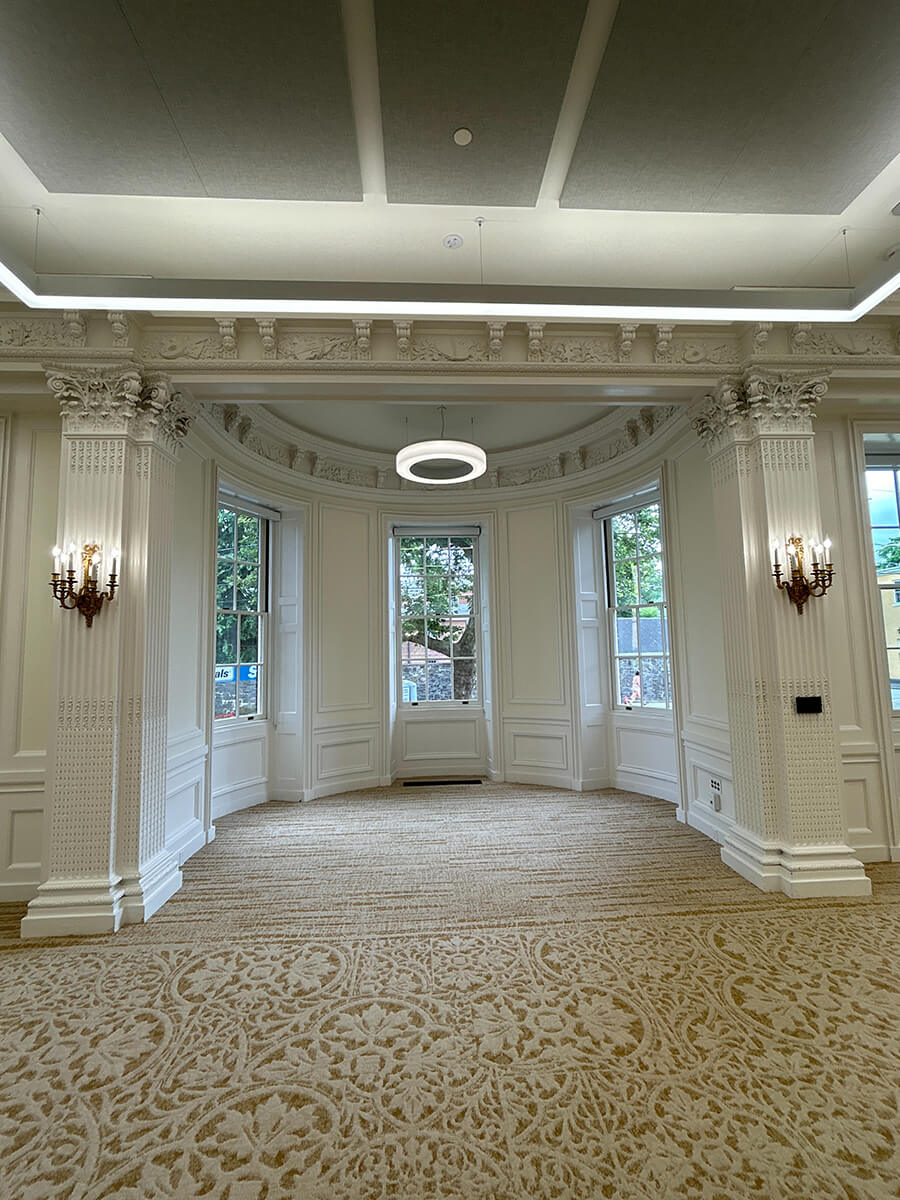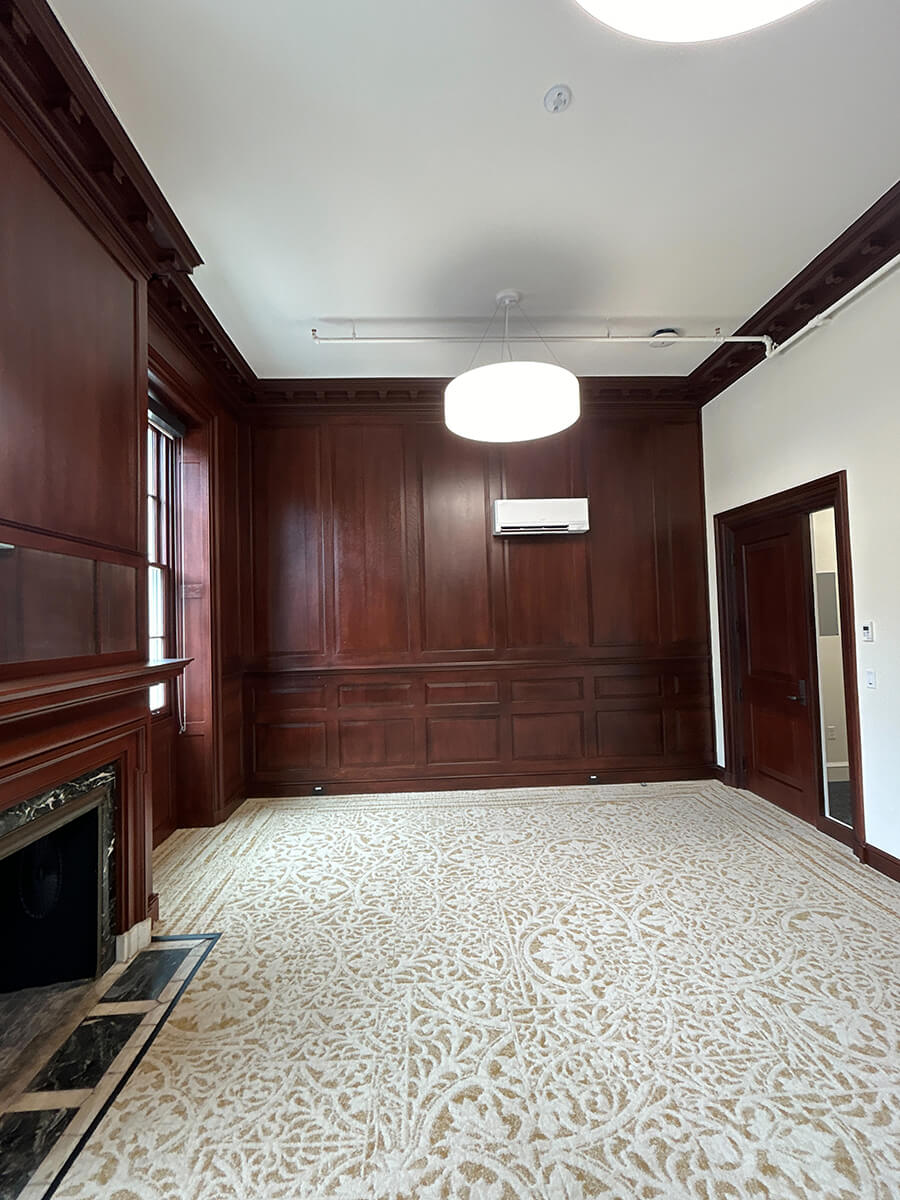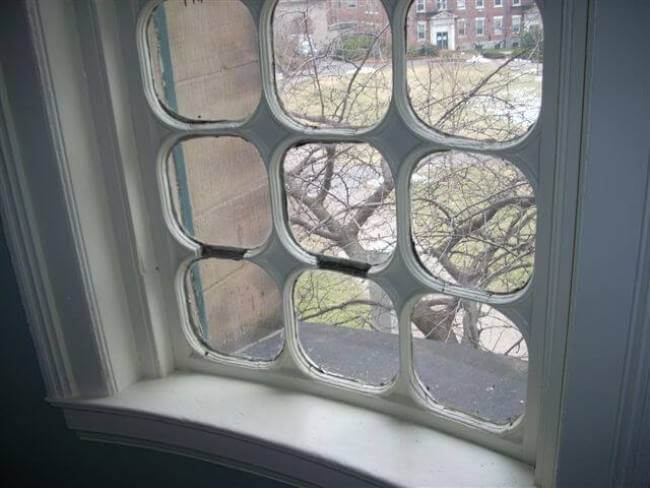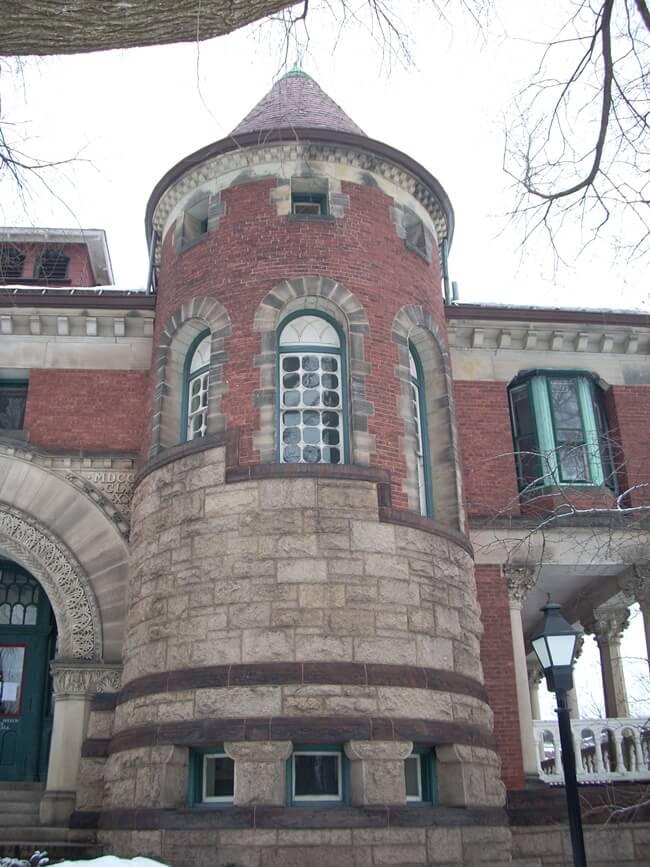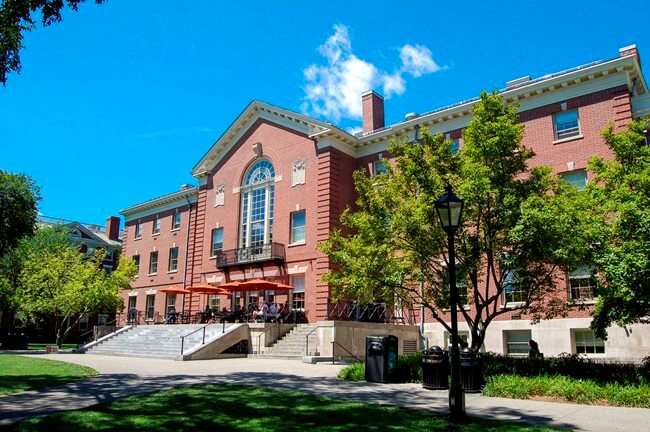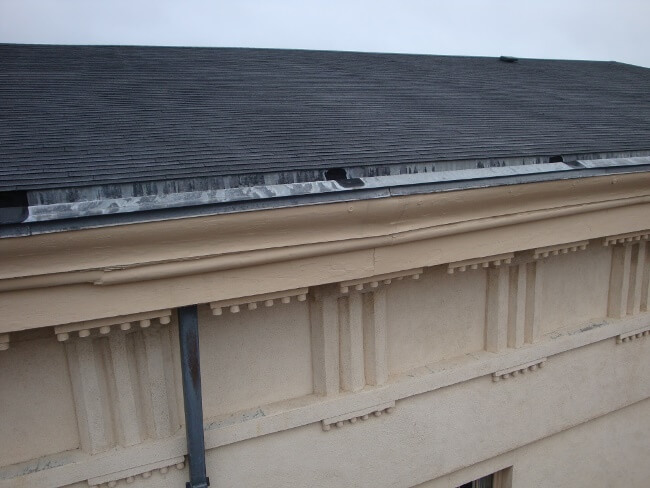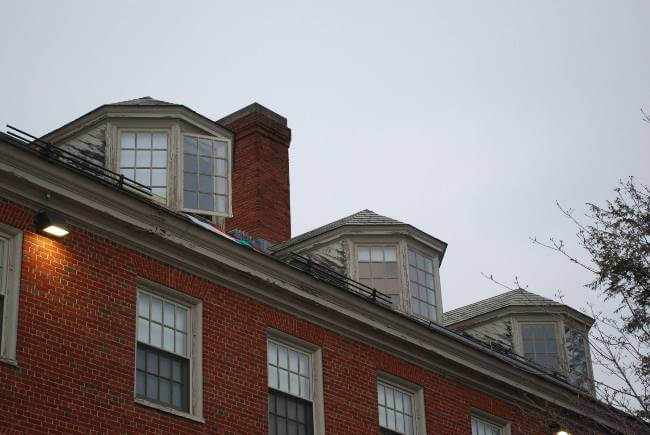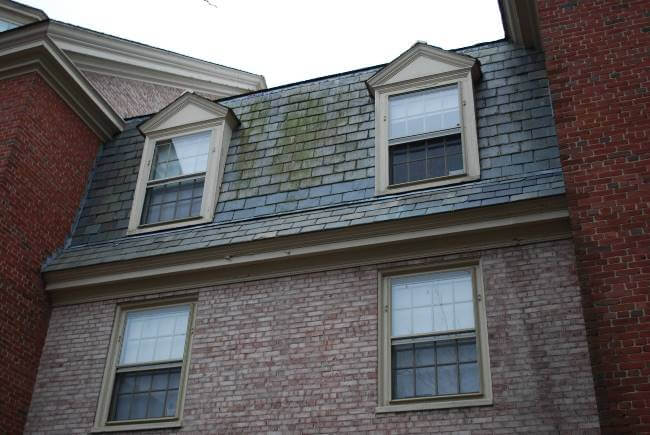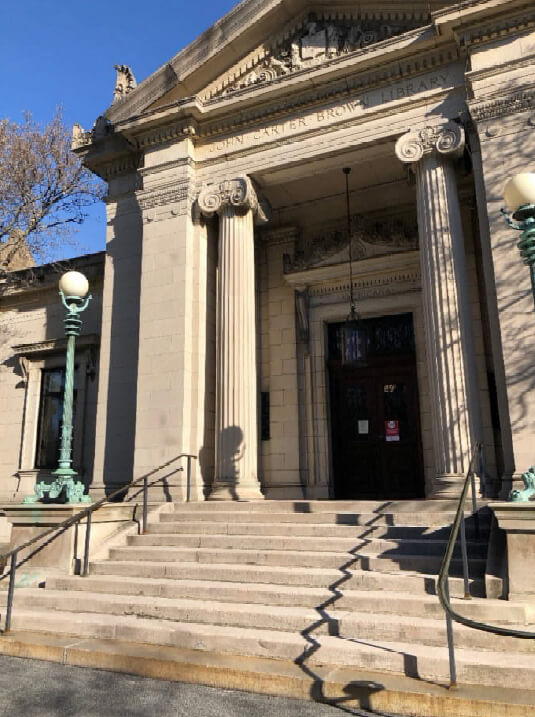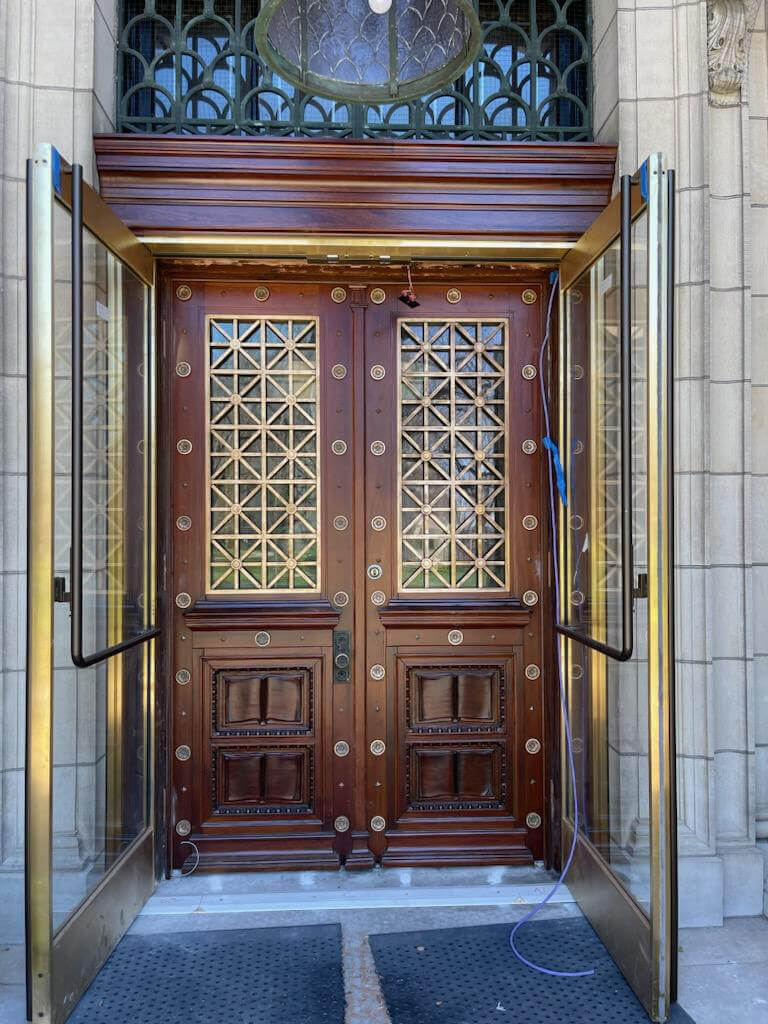Brown University
Location: Providence, RI
Noteworthy: The tower sashes were single glazed with flat glass rabbeted into the curved muntins and rails. M&A successfully replaced the existing glass with insulated glass without compromising the historic profiles or structural stability of the sash.
M&A’s Scope: Window and door restoration, interior historic millwork restoration, repair and replications
Owner: Brown University
Architects: Goody Clancy Architects
General Contractor: Shawmut Design and Construction
The building at 13 Brown Street in Providence, Rhode Island was originally built in 1901 as a 29-room mansion. The mansion at the time of its construction was described as “the crispest neo-Georgian house that Providence had thus far seen.”
In 1915, it became the Rhode Island Governor’s Mansion and then in 1922 was purchased by Brown University. It was in 1939 that the building became Andrews House, officially named after Elisha Benjamin Andrews, the president of the University from 1889 to 1898. From that time through the pandemic, the building was the student health care facility including the site for COVID-19 testing.
After the pandemic, Andrews House temporarily housed the Department of Africana Studies and the Rites and Reason Theatre. After the renovations it will be home to the Cogut Institute for the Humanities. The renovation and restoration of Andrews House is part of a 10-year strategic initiative entitled Building on Distinction.
Work Completed by M&A
1. Tower window restoration
Restoration of the tower sash posed several challenges:
- Replacement of the glazing, using 7/16” insulated flat glass installed into the curved 6-pane sash, complete with curved glazing beads and modified muntins, rails and stiles.
- Upper sash reconstruction where sash had been cut out to fit in air conditioning units. The sashes were unstable after the a/c units were removed, so not only did M&A fabricate new curved muntins and rails and repair stiles, but we had to repair the mortise-and-tenon joinery which had been damaged during the a/c modifications.
- Joinery of the lower sash rails was deteriorated from weather exposure, and new components were fabricated as needed to square up the sash securely.
2. Restoration of 9-foot high French doors, transoms and sidelights.
The massive doors had previously undergone modifications to replace the original glazing with laminated obscure glass. After restoration of the units, M&A replaced all the glazing with new, code-compliant tempered glass.
3. Millwork restoration
While on site, the need arose to make substantial modifications to stained paneling systems in the director’s office, and M&A was able to replicate damaged paneling, custom fabricating some delicate trim work, joining it seamlessly to the original components. There had been various penetrations and vertical channels cut into the paneling and M&A repaired the damage with custom-profiled, wood, dutchmen patches to blend with the existing panels.
Preserving and restoring historic buildings is our core expertise. We were honored to work at Andrews House at Brown University to repair, restore and protect the building’s architectural elements.
Location: Providence, Rhode Island
Noteworthy: Exact replication of three curved wood window sash with unique curved-corner square panes
Historic Designation: Part of the College Hill Historic District
M&A’s Scope: Wood window restoration at 130 openings, window sill replacement, replication of radius window sash, restoration of exterior balustrade, and historic door replication
Owner: Brown University
Architect: CBI Consulting
General Contractor: Shawmut Design and Construction
Built as a gymnasium for Brown University in 1891, Lyman Hall now houses the Leeds Theatre as well as Brown’s Theatre, Speech and Dance Departments. The brick and sandstone structure was designed by architects Stone, Carpenter, and Willson, a prominent firm in Providence, RI in the late 19th and early 20th centuries, in the Richardsonian Romanesque style.
In 2008, M&A was instrumental in the preservation of this iconic building, completing the following:
- Restoration of all the building’s 130 original wood windows
- Replacement of the dormer window sills, each of which contained a group of three windows.
- Replication of the three double-hung windows in the central tower, which houses a set of spiral stairs. These special radius double-hung windows display headers at the same height, and the size of the upper and lower sash elongates as the stairs descend. M&A fabricated new mahogany sash to the exact dimensions, detail, and profiles of the original windows, replicating the window’s unique fenestration pattern.
- Restoration of the building’s exterior balustrade at the building’s east elevation porch, which mimics the fenestration pattern of the tower windows. While M&A’s preservation carpenters restored portions of the porch balustrade, one of the ten foot lengths was replaced in whole, and large portions of the balustrade’s top rail were replaced in-kind.
- Replication of an historic door and frame, which open onto the building’s east elevation porch
Location: Providence, Rhode Island
Noteworthy: Historic replication of an eighteen foot Palladian wood window, complete with a floral medallion muntin pattern at the archtop
Historic Designation: Part of the College Hill National Historic District
Awards: LEED Gold Certification
M&A’s Scope: Historic wood window restoration, metal window repairs, and the fabrication of a new custom monumental wood window
Owner: Brown University
Architect: Schwartz/Silver Architects, Inc.
General Contractor: Shawmut Design and Construction
“My father stands ready to erect, furnish and give to the corporation of Brown University, free of expense, a building to be devoted primarily to the social and religious uses of the students of the university.” –John D. Rockefeller, Jr., on the construction of Faunce House (orig. Rockefeller Hall)
Faunce House has always been an important student facilities on Brown University’s campus. The Colonial Revival building, originally dedicated in 1904 as Rockefeller Hall, was constructed with funds from John D. Rockefeller, Jr., at the request of his father. The building housed a plethora of student organizations, large meeting halls, a reading room, and even a barber shop.
The building has undergone three major restorations in its history—the first was in 1930, when Rockefeller donated additional funds to enlarge the structure and re-name it after one of Brown’s well-loved presidents. The addition added a cafeteria and other dining spaces, and a theatre. During the subsequent decades, the building started to be occupied for more administrative-based, and less student-based, purposes. The second restoration occurred in the early 1980s, which worked to transition the building back to a student center. Most recently, a massive restoration project was undertaken during 2009-2010. Funded by private donations, the restoration’s goal was to create a space open and accessible to all members of the Brown community.
Original windows, whether found on 50 year-old buildings or 250 year-old buildings, are character-defining features for the buildings they adorn, and Brown was acutely aware of this fact for the restoration of Faunce House. M&A performed window-focused work as part of the 2009-2010 project, which included wood window restoration of half of the existing windows on the building, metal window repairs, and the fabrication of a new custom monumental wood window.
The large custom Palladian wood window, measuring nearly eighteen feet in height, is a beautiful example of the attention and sensitivity M&A pays to historic replications. The original wood window was removed, carefully documented, and exactly replicated to the historic profiles, dimensions, and design. The archtop component contains a floral medallion muntin pattern, a design popular during the Colonial Revival of the late 19th and early 20th centuries. The historic wood replication included not only the sash, but the surrounding pilasters, wainscoting, and trim.
Upon re-opening in the fall of 2010, the newly refreshed campus center has continued its life as one of Brown’s most beloved and utilized buildings. Students gather at the building today in the same way they did when it opened in 1904, maintaining the building’s original purpose.
Location: Providence, Rhode Island
Noteworthy: Discovery and correction of failed past repairs at a large 1830s exterior building cornice
Historic Designation: Part of the College Hill National Historic District
Owner: Brown University
General Contractor: Lee Kennedy Company
M&A’s Scope: Historic wood window restoration, metal window repairs, and the fabrication of a new custom monumental wood window
Owner: Brown University
Architect: Schwartz/Silver Architects, Inc.
General Contractor: Shawmut Design and Construction
The buildings surround the College Green, also called the Front Green, were constructed during the mid-19th century. Manning Chapel, originally Manning Hall, was built in the popular Greek Revival style of its time. It was designed in 1834 by architect James C. Bucklin. Originally housing the library on the first floor and chapel on the second floor, the rectangular building with a monumental Doric portico served many purposes over the years, including Army headquarters during WWI, and since 2005, as the gallery for the Haffenreffer Museum of Anthropology. Opposite Manning, the Salomon Center for Teaching was built in 1862 and was originally the Chemical Laboratory Building, then Rogers Hall. The eclectic brick structure is a blend of Moorish and Gothic Revival style architecture, with an overhanging wood cornice with brackets.
The scope of work at the Front Green included work at both Manning Chapel and the Salomon Center. The work included:
- Replication of the wood cornice and built-in gutter trough at Manning Chapel, which also involved re-plumbing and level cutting the existing roofing timbers to achieve straight lines for the cornice reinstall and other roof work
- Replication and installation of a new portion of the wood cornice at Salomon, as well as reattachment of the existing cornice in a separate location to achieve a straighter line at the building’s gutter edge
Interestingly, when M&A’s preservation carpenters took profile cuts of Manning Chapel’s cornice in order to fabricate custom profile knives, they discovered evidence of previous restoration repairs. The profile cuts taken from Manning Chapel to exposed a poor previous repair to the cornice. The original wood cornice had deteriorated to such an extent that to bring the profile back to its original shape, a past carpenter had placed thin cuts of wood within epoxy and applied this to the existing decaying cornice, shaping the round with these additional materials. A profile cut from the cornice in another location revealed a truer profile. Using these two cuts, M&A was able to determine the cornice profile, fabricate a certain length of new cornice, and install it so that the joint between the existing and new appeared seamless.
Location: Providence, Rhode Island
Noteworthy: Extensive repairs and in-kind replacement of Colonial Revival porticos, cornices, and mansard roof dormer windows
Historic Designation: Part of the College Hill National Historic District
M&A’s Scope: restoration and replacement of window surrounds, dormers, mansards, portico columns, cornices and cupola
Owner: Brown University
Architect: Lerner Ladds Bartels
General Contractor: Lee Kennedy Co.
Brown University’s Wriston Quadrangle is comprised of nine residential buildings built in the mid-20th century, between 1950 and 1952, with the unique purpose of housing fraternities on the ends of the buildings and individual students in the rooms at the core of the buildings. Built in the Colonial Revivial style to add architectural cohesion to Brown’s campus, the architectural firm of Perry, Shaw, and Hepburn oversaw the design of all nine buildings, which include Buxton, Chapin, Diman, Goddard, Harkness, Marcy, Olney, Sears, and Wayland.
In the summer of 2015, M&A returned to Brown to complete restoration work both at the Wriston Quad as well as the Front Green. At Wriston Quad, M&A’s work included:
- Extensive work at entry porticos at Buxton, Sears, Harkness, and Chapin, including epoxy consolidation and full replacement of bases, plinth blocks, columns or pilasters, and capitals as well as more intricate repairs such as epoxy restoration to dentils in the entry entablature at Chapin
- Epoxy repairs and replacement in-kind of rotting and decayed wood cornice, fascia boards, and cheek walls at mansard roof dormer windows
- Building cornice epoxy restoration and full wood replacement at areas of extensive deterioration
- Wood Dutchman repairs, front of sill replacement, and full wood sill replacement at basement windows
- Replacement of deteriorated wood at the base of the cupola wainscot at Wayland House
Location: Providence, Rhode Island
Noteworthy: Replicating historic millwork and retaining original doors in the construction of a new accessible building entrance
M&A’s Scope: Interior and exterior millwork of the entranceway; door and hardware restoration
Owner: Brown University
Architect: Perkins Eastman Architects DPC
General Contractor: Shawmut Design and Construction
John Carter Brown (1797-1874) came from a family of readers who collected books. It was in 1846 when he initiated one of the great collections of “Americana.” His private collection became a research library in 1904 at 94 George Street on the corner of the main green at Brown University.
An excerpt from the John Carter Brown mission statement includes “…preserving, expanding, and providing enhanced access to its world-renowned collection, the John Carter Brown Library inspires scholarship, stimulates innovative and creative engagement with its materials, and connects communities around the world with the history and culture of the early Americas.”
This project at the John Carter Brown library was focused on literally enhancing access to the library, part of the “Welcome and Access Project’. M&A Architectural Preservation was pleased to apply its restoration expertise to enable full accessibility to the building housing this extraordinary collection of books, maps and materials.
Work Completed by M&A:
While the changes to this gorgeous building were modest in relative terms, the undertaking that was part of the ‘Welcome and Access Project’ was described as huge in its practical and symbolic significance; a careful and elegant renovation of the front of the building.
M&A dismantled the original cornice, fabricated a new cornice to fit over the new accessible entrance, and refinished it to match the historic stained interior in the vestibule. This required reconfiguring the original cornice profile to accommodate the constraints of the reduced height of the opening, while maintaining as much of the original design as possible.
The original pair of exterior doors, along with their decorative hardware, were removed from the entry, cleaned, refreshed and reinstalled with the swing reversed.
Additionally, we were able to assist with patching and matching millwork in the historic vestibule to accommodate other upgrades of the interior space.

